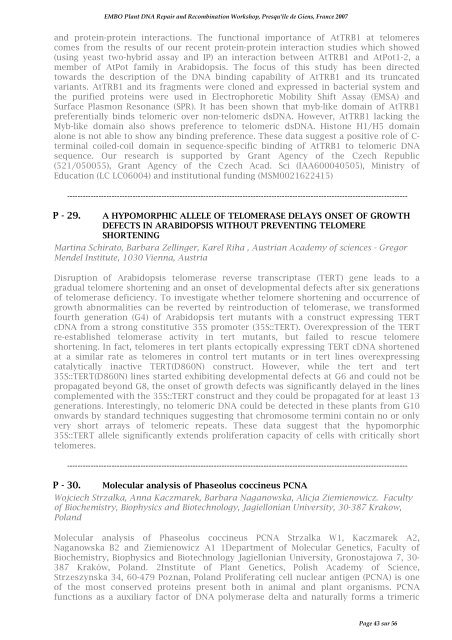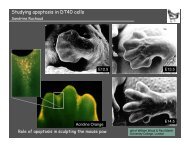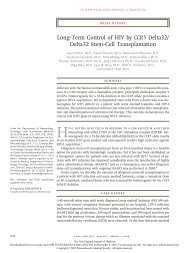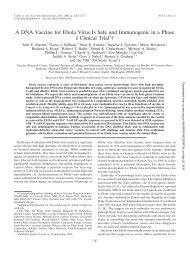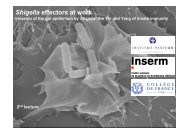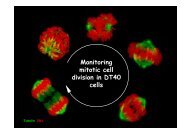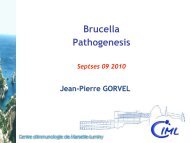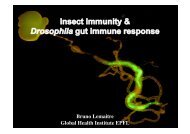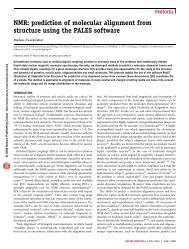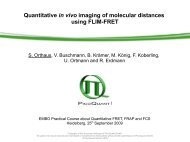pdf file - Events - EMBO
pdf file - Events - EMBO
pdf file - Events - EMBO
Create successful ePaper yourself
Turn your PDF publications into a flip-book with our unique Google optimized e-Paper software.
<strong>EMBO</strong> Plant DNA Repair and Recombination Workshop, Presqu'île de Giens, France 2007<br />
and protein-protein interactions. The functional importance of AtTRB1 at telomeres<br />
comes from the results of our recent protein-protein interaction studies which showed<br />
(using yeast two-hybrid assay and IP) an interaction between AtTRB1 and AtPot1-2, a<br />
member of AtPot family in Arabidopsis. The focus of this study has been directed<br />
towards the description of the DNA binding capability of AtTRB1 and its truncated<br />
variants. AtTRB1 and its fragments were cloned and expressed in bacterial system and<br />
the purified proteins were used in Electrophoretic Mobility Shift Assay (EMSA) and<br />
Surface Plasmon Resonance (SPR). It has been shown that myb-like domain of AtTRB1<br />
preferentially binds telomeric over non-telomeric dsDNA. However, AtTRB1 lacking the<br />
Myb-like domain also shows preference to telomeric dsDNA. Histone H1/H5 domain<br />
alone is not able to show any binding preference. These data suggest a positive role of Cterminal<br />
coiled-coil domain in sequence-specific binding of AtTRB1 to telomeric DNA<br />
sequence. Our research is supported by Grant Agency of the Czech Republic<br />
(521/050055), Grant Agency of the Czech Acad. Sci (IAA600040505), Ministry of<br />
Education (LC LC06004) and institutional funding (MSM0021622415)<br />
----------------------------------------------------------------------------------------------------------------------------------<br />
P - 29. A HYPOMORPHIC ALLELE OF TELOMERASE DELAYS ONSET OF GROWTH<br />
DEFECTS IN ARABIDOPSIS WITHOUT PREVENTING TELOMERE<br />
SHORTENING<br />
Martina Schirato, Barbara Zellinger, Karel Riha , Austrian Academy of sciences - Gregor<br />
Mendel Institute, 1030 Vienna, Austria<br />
Disruption of Arabidopsis telomerase reverse transcriptase (TERT) gene leads to a<br />
gradual telomere shortening and an onset of developmental defects after six generations<br />
of telomerase deficiency. To investigate whether telomere shortening and occurrence of<br />
growth abnormalities can be reverted by reintroduction of telomerase, we transformed<br />
fourth generation (G4) of Arabidopsis tert mutants with a construct expressing TERT<br />
cDNA from a strong constitutive 35S promoter (35S::TERT). Overexpression of the TERT<br />
re-established telomerase activity in tert mutants, but failed to rescue telomere<br />
shortening. In fact, telomeres in tert plants ectopically expressing TERT cDNA shortened<br />
at a similar rate as telomeres in control tert mutants or in tert lines overexpressing<br />
catalytically inactive TERT(D860N) construct. However, while the tert and tert<br />
35S::TERT(D860N) lines started exhibiting developmental defects at G6 and could not be<br />
propagated beyond G8, the onset of growth defects was significantly delayed in the lines<br />
complemented with the 35S::TERT construct and they could be propagated for at least 13<br />
generations. Interestingly, no telomeric DNA could be detected in these plants from G10<br />
onwards by standard techniques suggesting that chromosome termini contain no or only<br />
very short arrays of telomeric repeats. These data suggest that the hypomorphic<br />
35S::TERT allele significantly extends proliferation capacity of cells with critically short<br />
telomeres.<br />
----------------------------------------------------------------------------------------------------------------------------------<br />
P - 30. Molecular analysis of Phaseolus coccineus PCNA<br />
Wojciech Strzalka, Anna Kaczmarek, Barbara Naganowska, Alicja Ziemienowicz. Faculty<br />
of Biochemistry, Biophysics and Biotechnology, Jagiellonian University, 30-387 Krakow,<br />
Poland<br />
Molecular analysis of Phaseolus coccineus PCNA Strzalka W1, Kaczmarek A2,<br />
Naganowska B2 and Ziemienowicz A1 1Department of Molecular Genetics, Faculty of<br />
Biochemistry, Biophysics and Biotechnology Jagiellonian University, Gronostajowa 7, 30-<br />
387 Kraków, Poland. 2Institute of Plant Genetics, Polish Academy of Science,<br />
Strzeszynska 34, 60-479 Poznan, Poland Proliferating cell nuclear antigen (PCNA) is one<br />
of the most conserved proteins present both in animal and plant organisms. PCNA<br />
functions as a auxiliary factor of DNA polymerase delta and naturally forms a trimeric<br />
Page 43 sur 56


